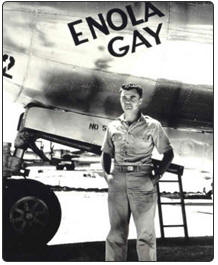

|
Pilot Of Enola Gay Dies At 92 November 2, 2007 – Brigadier General Paul Tibbets Jr., the pilot of the Enola Gay, the B-29 Superfortress that dropped the atomic bomb on Hiroshima in the final days of World War II, died November 1st at his home in Columbus, Ohio. He reportedly had had strokes in recent years. General Tibbets survived by his wife, the former Andrea Quattrehomme, two sons from his first marriage, Paul III and Gene, and a grandson, Colonel Paul Tibbets IV. Paul Warfield Tibbets Jr. was born on February 23, 1915, in Quincy, Illinois. His father was a salesman in a family grocery business and his mother, Enola Gay (whom he named his plane after) grew up on a farm in Iowa. At age 12, the family moved to Miami where Paul Tibbets rode with a pilot and dropped Baby Ruth candy bars as a promotional stunt. His dream for flying started there, and although his father wanted him to be a doctor, his mother encouraged him to pursue his dream. In 1937, Paul Tibbets joined the Army Air Corps after attending the University of Florida and University of Cincinnati. In late 1944, then Col. Tibbets was selected for the top-secret bombing mission over Japan -- the culmination of the Manhattan Project -- because of the piloting skill he showed early in the war during bombing runs over Europe and North Africa. He commanded the newly created 509th Composite Group, a unit of 1,800 best pilots, navigators, bombardiers, and crewman he found. In 1945 his unit was transferred for additional training on Tinian in the Northern Mariana Islands. In the hours before dawn on August 6, 1945, the Enola Gay lifted off Tinian carrying the uranium bomb known to its creator as Little Boy. At 8:15 a.m. local time, the bomb dropped onto Hiroshima, a city of about 250,000 people at the time. When the planes returned to Tinian, Tibbets was presented with the Distinguished Service Cross, the Army Air Forces’ highest award for valor after the Medal of Honor. After the Enola Gay flight, the Japanese did not surrender. Three days later, another U.S. crew made a run over Japan in a B-29 Superfortress named Bockscar, after its pilot, Frederick C. Bock. The primary target, Kokura, was fogged in, so they went for Nagasaki, an alternative target, and dropped a bomb nicknamed Fat Man. The Japanese formally surrendered Sept. 2, 1945.General Tibbets became an American hero after the flight that helped end the war, but he also received criticism for the controversial decision to use the atomic bomb in the war. |
|
|
 |
||
|
In a Public Broadcasting System documentary, "The Men Who Brought the Dawn," that aired on the 50th anniversary of the bombings, General Tibbets said the bomb "saved more lives than we took" because an alternative would have been an invasion of mainland Japan. "It would have been morally wrong if we'd have had that weapon and not used it and let a million more people die," he said. After being removed from the National Air and Space Museum in Washington, the Enola Gay found another home in December 2003. The fully restored and completed assembled plane was put in display at a newly opened Smithsonian air museum branch outside Dulles Airport in Virginia. |
||
| ©AvStop Online Magazine Contact Us Return To News | ||